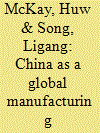| Srl | Item |
| 1 |
ID:
171645


|
|
|
|
|
| Summary/Abstract |
The European arms industry is challenged by several adverse “headwinds.” Fragmentation leads to costly duplications and, in conjunction with stagnating budgets and sharply increasing costs, prevents firms from exploiting economies of scale and learning. This is exacerbated by size differentials vis-a-vis the leading US arms manufacturers and competition from emerging producers. As some “headwinds” are self-enforcing, far-reaching industrial and policy responses are required to improve the industry's outlook. As exports may not indefinitely compensate for low domestic demand, there is an economic imperative for further cross-border collaboration and consolidation. Despite various EU policy initiatives, progresses regarding the European Defence Equipment Market and strengthening the European Defence Technological Industrial Base have been relatively slow. It remains to be seen whether the European Defence Fund will be the proclaimed “game-changer,” raising competitiveness of the European arms industry. At the same time, the UK's withdrawal from the EU adds uncertainties.
|
|
|
|
|
|
|
|
|
|
|
|
|
|
|
|
| 2 |
ID:
096230


|
|
|
|
|
| Publication |
2010.
|
| Summary/Abstract |
The present paper explores the role of China in the creation of the current global financial crisis and the impacts of the crisis on its economy. It argues against the view that the "saving glut" in China (along with other Asian emerging economies) played a significant causal role in the crisis. The global financial crisis did not engender much damage in China's financial structure, thanks to the relatively closed, bank-centered financial system. However, the impacts on the "real" side of the Chinese economy were hard felt. Growth and employment have fallen, largely due to the decline in exports and foreign direct investment. The crisis reveals the vulnerability of the export-dependent growth pattern. Policy responses of the Chinese Government, including monetary, fiscal and social policies, have helped to stem the downfall of the economy in the immediate term, but some of the policies have not addressed the structural problems of the Chinese economy and might well aggravate such problems over time. The present paper proposes a tentative reform blueprint to rebalance the economy and to sustain long-term growth.
|
|
|
|
|
|
|
|
|
|
|
|
|
|
|
|
| 3 |
ID:
096221


|
|
|
|
|
| Publication |
2010.
|
| Summary/Abstract |
This study examines the nature and consequences of China's rise to the center of world economic affairs through manufacturing-led development. Our historical analysis shows that China is still well short of the point in its developmental process where its growth might be reasonably expected to slow, or the energy, resource and carbon intensity of growth to recede. The study argues that the current trajectory of industrialization will have to be altered when China becomes more actively engaged in dealing with structural issues at home and abroad against the background of the unwinding of global imbalances. One profitable strategy that China might employ would be to approximate the incredibly fruitful mass-market integration efforts of the USA that eventually elevated it to its position of global primacy. The cyclical re-emergence of excess capacity in Chinese heavy industry, serious questions about the medium term ability of other major regions to accommodate further large gains in Chinese market share, and the stark conflict between the contemporary style of industrial development and the health of the biosphere indicate strongly that now is the time to catalyze the required adjustment and reform processes that will underpin sustainable long-run prosperity.
|
|
|
|
|
|
|
|
|
|
|
|
|
|
|
|